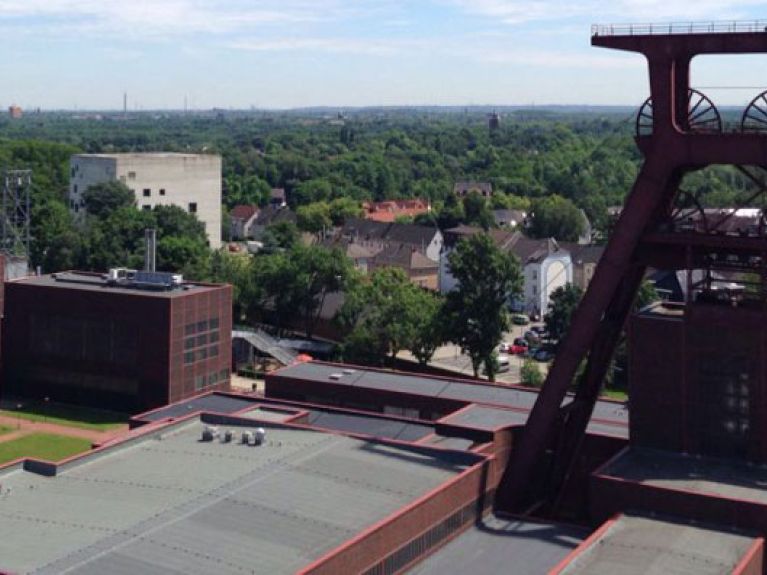The Future of Our Cities
How do we want to live? Architects, urban planners and other experts from around the world explored some of the ideas emanating from Germany. A lot of those ideas are inspiring, not all of them, however, can be realised.

Kiran Venkatesh almost sounded a little moved. “I would like to congratulate you on this concept,” said the architect from Bangalore after the Head of the Environmental Department of the City of Essen had finished her speech. “That sounds like a future I’d like to live in.” The future he was talking about is the one planned for the city of Essen – one that is to become reality as early as 2017. That is when this city in Germany’s Ruhr region, which was characterised for so long by coal and steel production, is to bear the title “European Green Capital”. This is what makes Essen an exciting destination for the group Venkatesh is part of. The 15-strong delegation, whose members come from all over the world, is travelling to Berlin, Dessau and Essen for a week as guests of the Visitors Programme of the Federal Republic of Germany. The aim of the visit is for them to hold talks and exchange views with experts on sustainable urban development and energy efficient planning and building in Germany.
In addition to the green ideas, many of the participants are delighted by the idea of lots of dashes of the colour blue in the plans for Essen. The Head of the Environmental Department, Simone Raskob, puts it like this, “We are giving the river back to the people.” What they are working on is truly a long-term project – the river Emscher is to be restored to its natural state. As the process of industrialisation progressed, the river turned into an open sewage system. “Emscher” – for the residents of the Ruhr region the very name alone was synonymous for a long time with such things as stench, dark sludge and health hazards. Now the effluent water is to flow underground via a network of newly laid sewerage canals – around 400 kilometres of them at a depth of up to 40 metres. The old riverscape itself is to become a place for relaxation and leisure.
“Bangalore used to be known as the city of lakes,” says Venkatesh, referring to his own home town. “But we lost them all.” The lakes are either completely polluted or they have been built on. Making this point, the architect also makes clear that there are in fact differences between Germany and India – no matter how much he is thrilled, the ideas from Essen can only be realised to a limited extent. “In a growing metropolis like Bangalore real estate just happens to be the most important currency.”
The fact that for the Ruhr region it is more important to deal with structural change and shrinking cities, became perfectly clear to the visitors the next day when they climbed up to the observation deck of the Ruhr Museum. The museum is located in the complex of Zollverein, once the largest hard coal mine in the world, now a UNESCO World Heritage Site. When the mine closed in 1986, a huge piece of land remained, for which new users had to be found. Today Zollverein attracts visitors from all over the world – in 2015 there were 1.5 million of them. In the Ruhr Museum they learn about the region’s industrial culture, they attend concerts or dance performances in the old factory halls – or they go to university. The renowned Folkwang University holds courses on the site in a building that was designed by the Japanese architecture firm SANAA and it is currently constructing another. On the surrounding paths you can see cyclists and inline skaters doing the rounds.
“I like the fact that a lot of holistic thinking is going on here”, says Anita Morandini. The architect, who, among other places, also studied at the Städelschule in Frankfurt, is Design Excellence Manager of the City of Sydney. She supervises a programme whose aim is to enhance the quality of new buildings in the Australian metropolis. With the added incentive of having their projects funded, the people involved are encouraged to meet certain criteria in the design and sustainability of their projects. There was at least one building that Ms. Morandini saw during her trip to Germany that would satisfy her criteria and that would have obtained funding in Sydney – in Dessau.
The international experts did not only visit the buildings of the Bauhaus school in the city on the river Elbe – “A veritable pilgrimage” said Colin Andrew Neufeld, an architect from Winnipeg in Canada. The German Federal Environment Agency (UBA) has also had its headquarters in Dessau since 2005. The building is an unusual construction that has since won several prizes, it was also awarded, among other things, the German Seal of Approval in Gold for Sustainable Construction. With its photovoltaic systems, solar panels and geothermal heat exchangers the designers focused strongly on renewable energy. The building is also impressive visually. The colourful facade is inviting and the inside creates the impression of being in a large garden. There are birds fluttering around, employees walk to their offices through greenery and via passageways that are reminiscent of hanging bridges. The whole complex gives the impression of being open and lively.
The fact that the architecture prompts colleagues to start communicating with each other also scored a few extra points for Ms. Morandini. “Here, the social aspect was taken into account.” The Australian had found out the day before in Berlin what kind of thinking had spawned such designs – the group had been invited to visit the architectural firm of Sauerbruch Hutton, which had designed the UBA.
More about the Visitors Programme of the Federal Republic of Germany